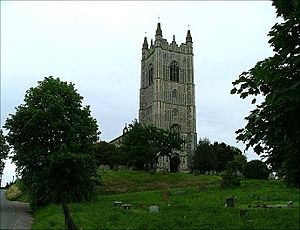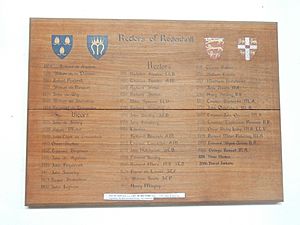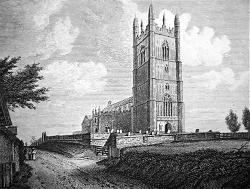Church of the Assumption of the Blessed Virgin Mary, Redenhall facts for kids
Quick facts for kids Church of the Assumption of the Blessed Virgin Mary, Redenhall |
|
|---|---|

St Mary's Church, Redenhall
|
|
| 52°24.67105′N 1°19.61998′E / 52.41118417°N 1.32699967°E | |
| Location | Redenhall |
| Country | England |
| Denomination | Church of England |
| Website | http://www.7churches.org.uk/ |
| History | |
| Dedication | Assumption of Mary |
| Architecture | |
| Heritage designation | Grade I listed |
| Style | Perpendicular |
| Groundbreaking | 1326 |
| Completed | 1518 |
| Specifications | |
| Length | 137 feet (42 m) |
| Width | 59 feet (18 m) |
| Height | 106 feet (32 m) |
| Administration | |
| Parish | Redenhall with Harleston and Wortwell |
| Deanery | Redenhall |
| Archdeaconry | Norfolk |
| Diocese | Diocese of Norwich |
| Province | Canterbury |
The Church of the Assumption of the Blessed Virgin Mary, Redenhall, often called St. Mary's Church, is a very old and important church in Redenhall, Norfolk, England. It is part of the Church of England. This church is considered a Grade I listed building, which means it is a very special historical site. It is the main church for the larger area of Redenhall-cum-Harleston and Wortwell. There is also a smaller church, St John the Baptist in Harleston, which used to be a smaller chapel connected to Redenhall.
Contents
History of St. Mary's Church
People have been worshipping at the site of St. Mary's Church in Redenhall for about 1,000 years or even longer. In 1858, workers found signs of an even older church beneath the current one. This earlier church likely had a round tower and was built during the Saxon or Norman times. They found these old foundations when they were putting in a new heating system.
Building the Church Over Time
The oldest part of the church you see today is the chancel. This section was built in the early 1300s. It might have been added to an even older church that was already there. The person responsible for maintaining the chancel was the rector. William de Neuport, who was the rector from 1319 to 1326, is thought to have paid for the chancel we see now.
The 1400s and 1500s were a time when many grand churches were built or rebuilt in the East Anglia region of England. The main part of the church, called the nave, and its side sections, known as aisles, were built during this period.
The Magnificent Tower
The most impressive part of St. Mary's Church is its tall tower. Construction on this tower began around 1460. Many people left money in their wills between 1469 and 1514 to help pay for its building. The tower stands very tall, reaching 106 feet (32 meters) to the very top of its decorative points called pinnacles.
External links
- Visit the church website



